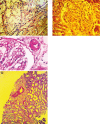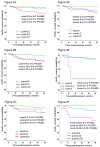Significance of the Pathologic Findings in Implantation Biopsies for Kidney Allografts Survival
- PMID: 30891166
- PMCID: PMC6416998
Significance of the Pathologic Findings in Implantation Biopsies for Kidney Allografts Survival
Abstract
Background: There is no consistent association between individual histological lesions and composite scores in donor kidney biopsy and transplant outcomes.
Objective: To evaluate which acute or chronic individual histological lesions and composite scores in donor kidney were associated with graft survival in the recipient.
Methods: We investigated the association of individual histological lesions and 8 composite scoring systems in implantation biopsies of cadaveric (n=101) and living (n=29) kidneys with 5-year death-censored graft survival.
Results: We found a high frequency of chronic lesions in donor kidneys, mostly associated with arteriosclerosis, and less dependent from donor age. Acute, chronic, and total Banff scores for post-transplant biopsies, chronic and total Banff scores for pre-implant biopsies, donor damage score and chronic damage score predicted death-censored graft loss. However, only chronic and total Banff-scores had significant effects in multivariate model. Chronic pre-implant and total post-transplant Banff scores demonstrated the highest area under the curve (AUC) of 0.722 and 0.717, respectively. Among individual lesions, glomerulosclerosis ≥20%, interstitial inflammation >0, arteriosclerosis =3, arteriolar hyalinosis >0, and interstitial fibrosis >0, assessed with Banff-grading criteria, were associated with lower allograft survival. We created the Donor Kidney Damage Index (DKDI), by summing regression coefficients for these lesions, which yielded the AUC of 0.747. When combined with retransplantation, cold ischemia time and acute rejection, DKDI, chronic pre-implant and total post-transplant Banff scores further improved their predictive accuracy, yielding AUCs of 0.842, 0.807, and 0.802, respectively.
Conclusion: DKDI, chronic pre-implant and total post-transplant Banff scores alone and combined with clinical variables may facilitate decision making in post-transplant period.
Keywords: Implantation biopsy histology; Individual and composite histological scores; Kidney allograft survival.
Conflict of interest statement
None declared.
Figures



References
-
- Balaz P, Rokosny S, Wohlfahrtova M, et al. Identification of expanded-criteria donor kidney grafts at lower risk of delayed graft function. Transplantation. 2013;96:633–8. - PubMed
-
- Kayler LK, Mohanka R, Basu A, et al. Correlation of histologic findings on preimplant biopsy with kidney graft survival. Transpl Int. 2008;21:892–8. - PubMed
-
- Schold JD, Kaplan B, Baliga RS, Meier-Kriesche HU. The broad spectrum of quality in deceased donor kidneys. Am J Transplant. 2005;5:757–65. - PubMed
-
- Carta P, Zanazzi M, Caroti L, et al. Impact of the pre-transplant histological score on 3-year graft outcomes of kidneys from marginal donors: a single-centre study. Nephrol Dial Transplant. 2013;28:2637–44. - PubMed
LinkOut - more resources
Full Text Sources
